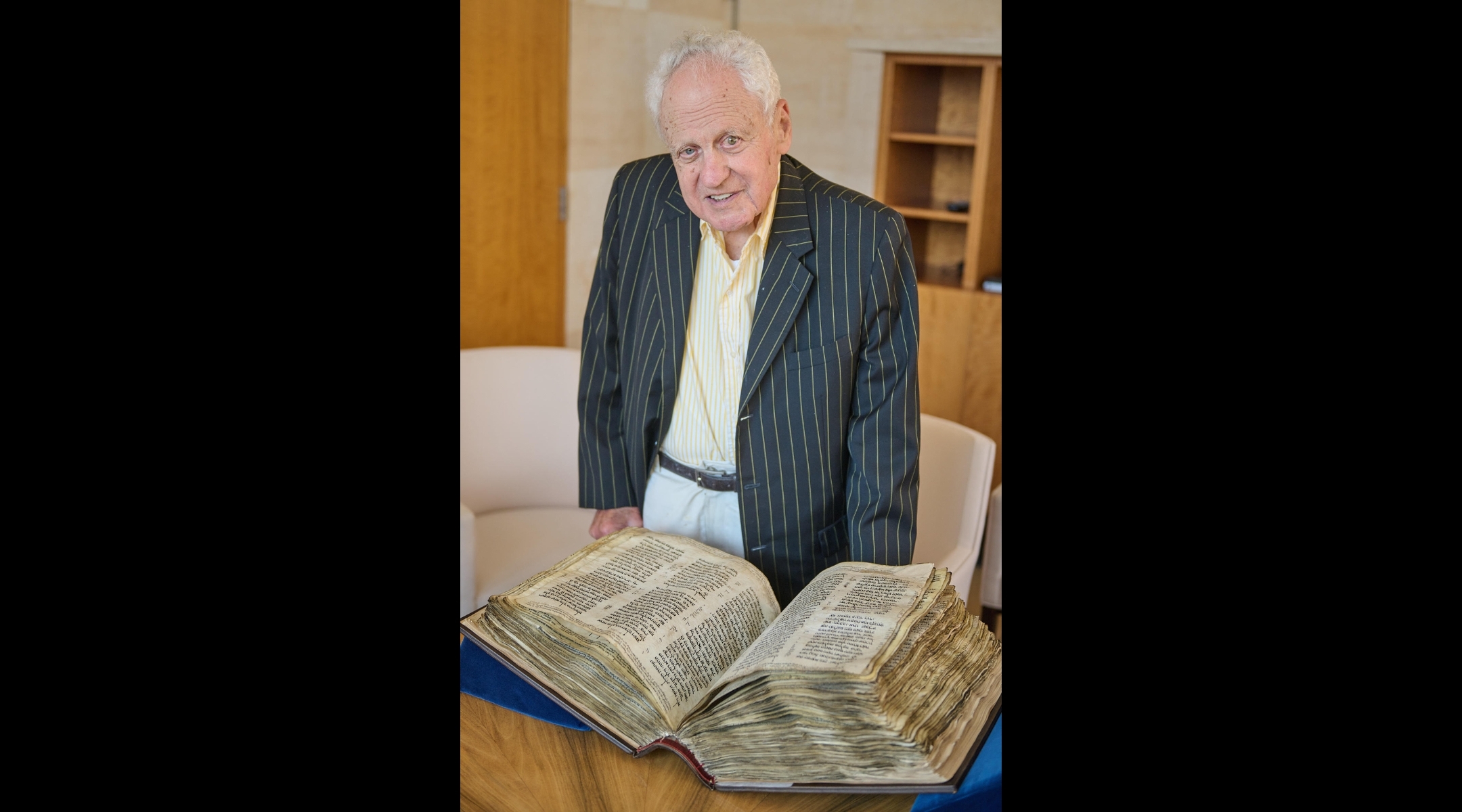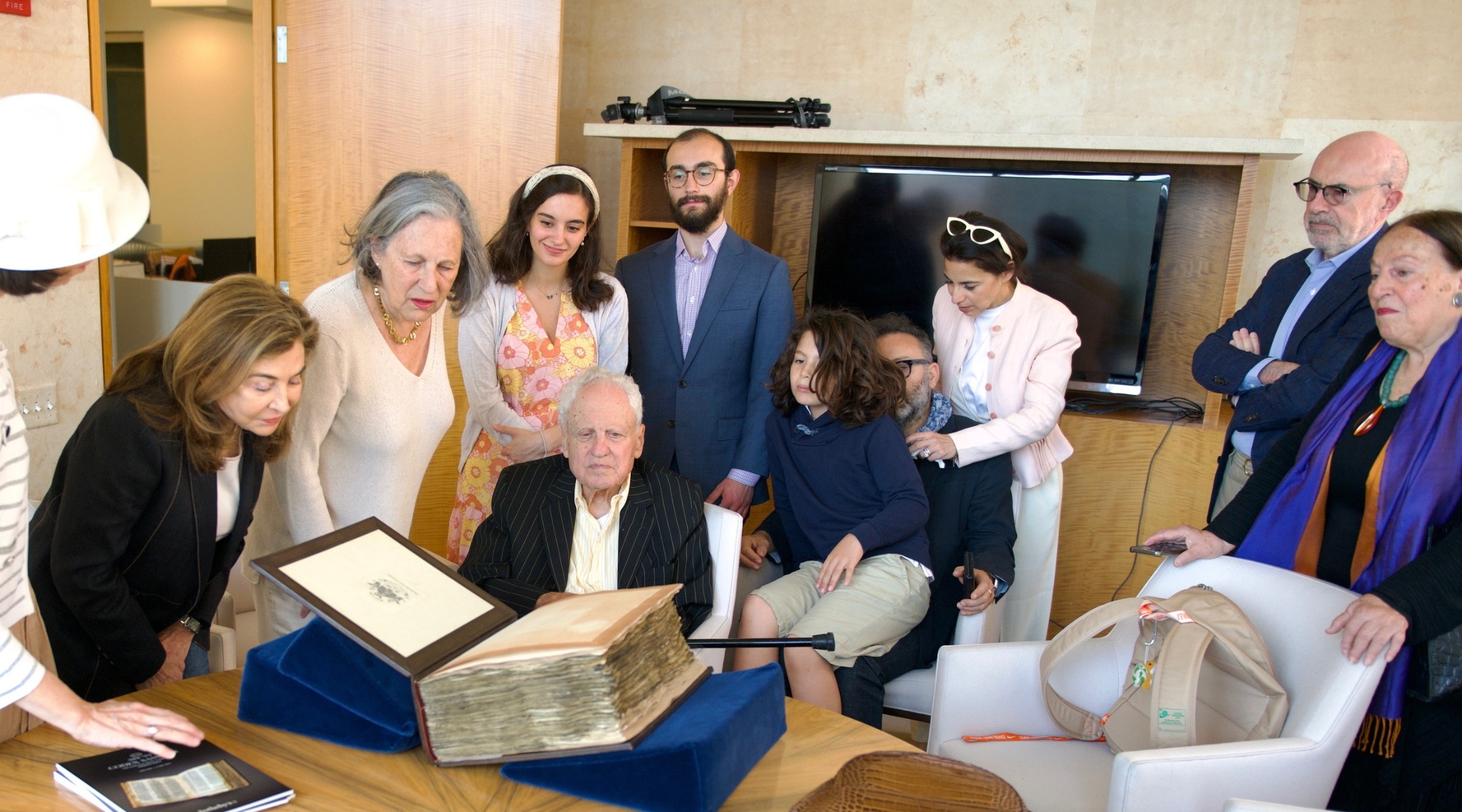Alfred Moses bought the Codex Sassoon for more than $30 million. He just saw it for the first time.
“I thought my chances were about 50/50,” Moses said about the auction where he bought the more than 1,000-year-old book two weeks ago

Alfred Moses purchased the Codex Sassoon for more than $30 million and will be donating it to the ANU Museum of the Jewish People in Tel Aviv. (Perry Bindelglass for The American Friends of ANU The Museum of the Jewish People)
(JTA) — On Wednesday morning, Alfred Moses, 94, sat in a small white armchair at a round wooden table in a Manhattan office building as a historian gingerly turned the pages of a more than 1,000-year-old book in front of him.
Two weeks earlier, Moses had paid a record-setting sum for the book — more than $38 million in total. But this was the first time he had ever seen it.
The book was the Codex Sassoon, the world’s oldest nearly-complete copy of the Hebrew Bible. That morning, in Sotheby’s Upper East Side office, Sharon Mintz, the auction house’s senior Judaica specialist, was giving Moses and some of his relatives a history lesson on his new acquisition.
Mintz turned the pages with clean, bare hands, noting the scored ruling between the lines of text and the thickness of the parchment pages — made somewhat thinner in places where scribes scratched over each others’ notes. Before Moses bought the book at a much-anticipated Sotheby’s auction on May 17, the codex passed between multiple owners — most recently through the hands of Jacqui Safra, a member of the prominent banking family, and before him, in the 1920s, Jewish book collector David Solomon Sassoon.
It will now be housed at the ANU Museum of the Jewish People in Tel Aviv, which exhibited the codex earlier this year.
“It’s an inspiring book, to see a 1,200 year old manuscript in perfect [condition] — even that we can read today — it’s quite amazing,” Moses said. “It has the vowels and the trope … it’s remarkable. It’s something that’s been preserved for 1,200 years. And we’re the beneficiaries of it.”
Moses is an attorney who served as U.S. ambassador to Romania during the Clinton administration and is a past president of the American Jewish Committee. He had anxiously watched the auction online from his home in Washington, D.C., worried that another possible bidder, like the Bible Museum, also in Washington, might put in a competitive bid. Representatives from the American Friends of ANU, which supports the museum, were concerned it might wind up in a private collection, and could be lost to public view for another generation.
“I thought my chances were about 50/50,” Moses said. “But I was prepared to buy it if I could afford to.”
He expected to pay as much as $32.5 million, which he put in as an “irrevocable bid” with Sotheby’s ahead of the auction, according to Bloomberg. He ended up inching his bid up to $33.5 million after someone else bid $33 million. Fees brought his final tab to $38.1 million.
Part of the reason he decided to give the book to ANU — an institution he has supported for years, including as chair of its honorary board — is that he sees it as serving Jews worldwide. He feels other prestigious homes for historical artifacts in the country, such as the Israel Museum in Jerusalem, are meant to cater to Israelis specifically.
“It’s the museum of the Jewish people and I wanted the codex to go to the Jewish people,” he said. “The Israel Museum is wonderful. But that’s the museum for Israel. I wanted the codex to be for the Jewish people.”

Moses is making the hefty donation to Israel at a fraught time, as street protests across the country are raging at the government’s attempt to weaken the judiciary, and as friction persists between the Biden administration and Israel’s right-wing government. But Moses sees the tension as a passing phase.
“I think there’s a bit of concern among American Jews as to what is happening politically in Israel, but that’s temporal. 20 years from now, it’ll seem like history,” Moses said. “One has to have a sense of history in the longer viewpoint. Israel is the home of the Jewish people. Whom the Israelis elect to be their government and the prime minister is an Israeli decision.”
But Moses mused that the book could leave Israel after all. During the lesson, Mintz explained that part of the mystery of the book’s provenance is its disappearance from the medieval town of Makisin, in present-day Markada, Syria, sometime around the year 1400. According to an inscription on the book’s last page, it was removed from the synagogue during an attack on the town and entrusted to the care of Salama ibn Abi al-Fakhr, who was instructed to return it as soon as Makisin was rebuilt.
It was during this part of the lesson that Moses cracked a joke: if the Jewish community returns to what is now Markada, would he have to return the book?
Given the condition of Syria after more than a decade of fighting, and the almost total loss of its once thriving Jewish community, that prospect seems remote. Mintz also noted that while the existence of the codex in what is present-day Markada has been established, little else is known about the Jewish community that existed there. For now, Moses hopes that the cultural treasure he bought will be seen as the property of Jews everywhere.
“I think the Sassoon Codex will give satisfaction, joy, and pride to tens of thousands, maybe hundreds of thousands, maybe millions of viewers,” Moses added. “I see benefit to the Jewish people.”
This article originally appeared on JTA.org.
















